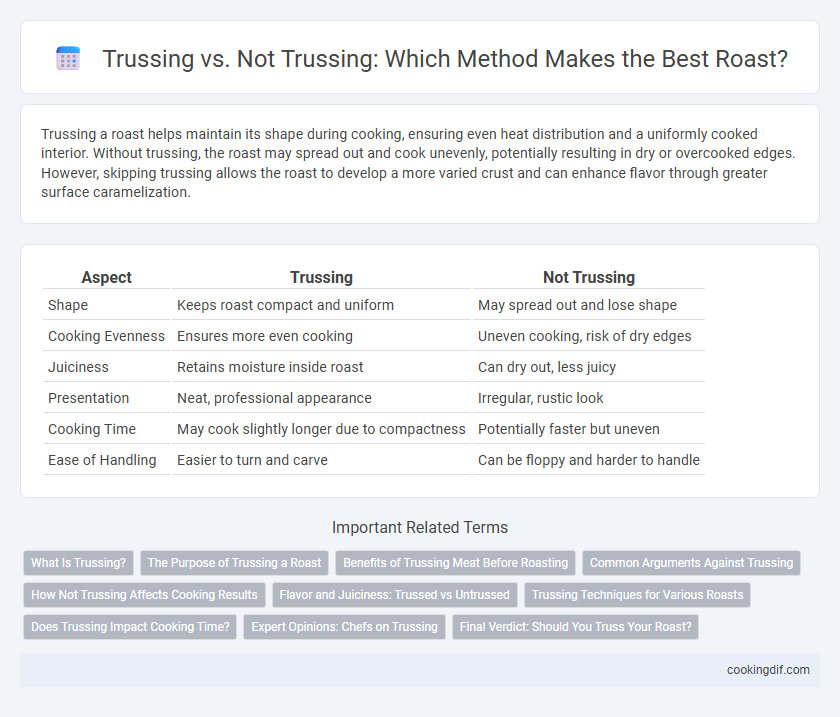Trussing a roast helps maintain its shape during cooking, ensuring even heat distribution and a uniformly cooked interior. Without trussing, the roast may spread out and cook unevenly, potentially resulting in dry or overcooked edges. However, skipping trussing allows the roast to develop a more varied crust and can enhance flavor through greater surface caramelization.
Table of Comparison
| Aspect | Trussing | Not Trussing |
|---|---|---|
| Shape | Keeps roast compact and uniform | May spread out and lose shape |
| Cooking Evenness | Ensures more even cooking | Uneven cooking, risk of dry edges |
| Juiciness | Retains moisture inside roast | Can dry out, less juicy |
| Presentation | Neat, professional appearance | Irregular, rustic look |
| Cooking Time | May cook slightly longer due to compactness | Potentially faster but uneven |
| Ease of Handling | Easier to turn and carve | Can be floppy and harder to handle |
What Is Trussing?
Trussing is the culinary technique of tying meat, typically a roast, with kitchen twine to maintain its shape and promote even cooking. This method helps the roast retain moisture, prevents uneven cooking, and ensures a uniform, attractive appearance when served. Opting not to truss may result in a less compact roast that can cook unevenly and lose its juices.
The Purpose of Trussing a Roast
Trussing a roast ensures even cooking by securing the meat's shape, which helps maintain uniform thickness and prevents uneven heat exposure. It enhances the roast's appearance by keeping loose strands or stuffed fillings intact, resulting in a visually appealing presentation. Without trussing, the roast may spread out, cook unevenly, and lose juices, compromising texture and flavor.
Benefits of Trussing Meat Before Roasting
Trussing meat before roasting helps maintain a uniform shape for even cooking and enhances moisture retention, resulting in a juicier roast. It prevents the meat from spreading or drying out, preserving tenderness and flavor throughout the cooking process. Additionally, properly tied roasts cook more efficiently, reducing the risk of overcooked or undercooked sections.
Common Arguments Against Trussing
Common arguments against trussing a roast include the potential for uneven cooking due to restricted heat circulation and the risk of a less crispy crust as the string can trap moisture against the meat surface. Critics argue that leaving a roast untrussed allows for better browning and a more flavorful, caramelized exterior. Some also claim that not trussing enables juices to redistribute more naturally during cooking, resulting in a juicier final product.
How Not Trussing Affects Cooking Results
Not trussing a roast allows heat to circulate more evenly around the meat, resulting in a crisper, well-browned crust and more pronounced flavor development. However, the roast may cook unevenly, with thinner edges potentially drying out while the thicker center remains juicier. This method is ideal for cuts where a rustic appearance and variable texture are desired, though it requires careful monitoring to prevent overcooking.
Flavor and Juiciness: Trussed vs Untrussed
Trussing a roast helps maintain its shape during cooking, promoting even heat distribution and enhanced juiciness by preventing moisture loss. Conversely, an untrussed roast allows for greater surface exposure, which can develop a more flavorful, crispy crust but may risk uneven cooking and reduced internal moisture. The choice between trussing and not trussing depends on balancing a tender, juicy interior with the desired exterior texture and flavor intensity.
Trussing Techniques for Various Roasts
Trussing techniques vary based on the type of roast, with poultry often requiring tight, even trussing to ensure uniform cooking and maintain shape, using kitchen twine tied around the legs and wings. For beef or pork roasts, trussing helps retain moisture and promotes even browning by securing loose edges and stuffing, usually with a simple but firm loop-around method. Different roasts benefit from specific trussing patterns that optimize heat distribution, presentation, and texture during roasting.
Does Trussing Impact Cooking Time?
Trussing a roast can slightly reduce cooking time by promoting even heat distribution and preventing uneven thickness, which helps the roast cook more uniformly. Without trussing, the meat may cook unevenly, potentially requiring a longer cooking time to ensure the thicker parts reach the desired internal temperature. However, the difference in cooking time is usually minimal, and the main benefit of trussing lies in achieving a consistent shape for better presentation and moisture retention.
Expert Opinions: Chefs on Trussing
Expert chefs agree that trussing a roast ensures even cooking and maintains the meat's shape, which enhances presentation and texture. Without trussing, the roast can cook unevenly and lose moisture, resulting in a less succulent dish. Culinary experts emphasize that trussing also helps ingredients like herbs and aromatics remain securely attached during roasting, intensifying flavor.
Final Verdict: Should You Truss Your Roast?
Trussing a roast ensures even cooking by holding the shape together, preventing uneven heat exposure and maintaining moisture retention for a juicier texture. Untied roasts may cook faster but risk dry edges and irregular doneness due to inconsistent heat distribution. For optimal flavor and presentation, trussing is recommended to enhance uniformity and tenderness in the final roast.
Trussing vs not trussing for roast Infographic

 cookingdif.com
cookingdif.com